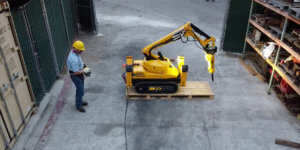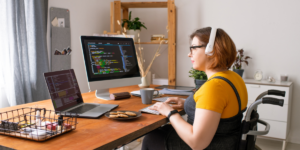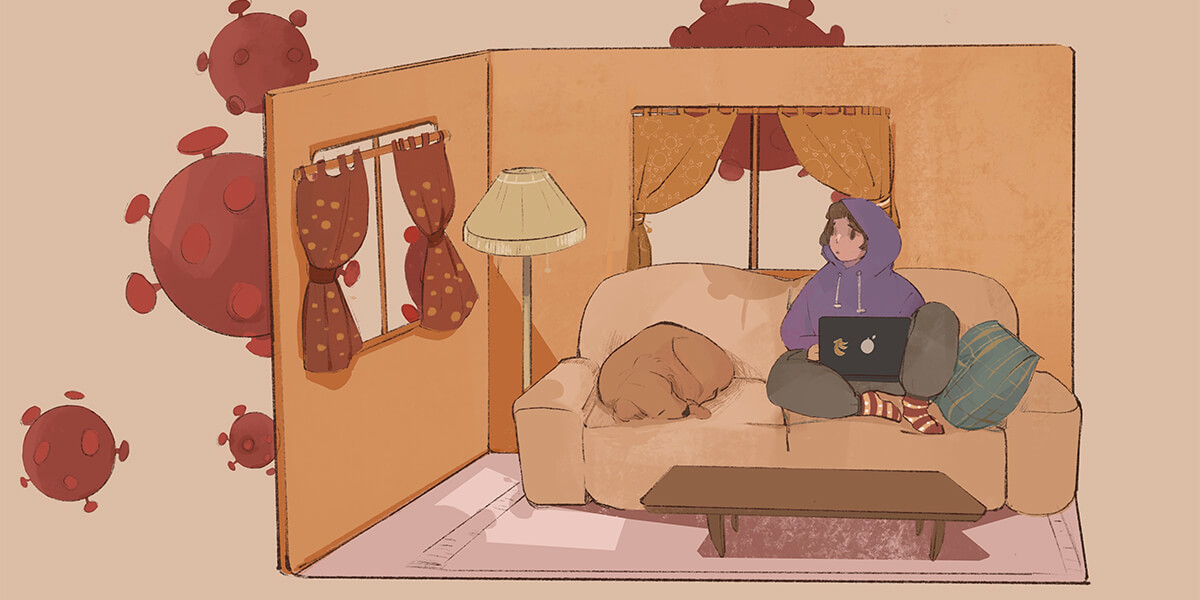
ILLUSTRATION/SHUTIANYI LI.
This fall, following the National Academy of Engineering (NAE) Call to Action for engineers to “crowdsource and collectively brainstorm engineering solutions for the coronavirus disease (COVID-19),” the USC Viterbi School of Engineering is offering “Viterbi vs. Pandemics!” — a new lecture series by USC Viterbi faculty to comprehensively provide an engineering-centric framework for addressing and understanding the COVID-19 pandemic.
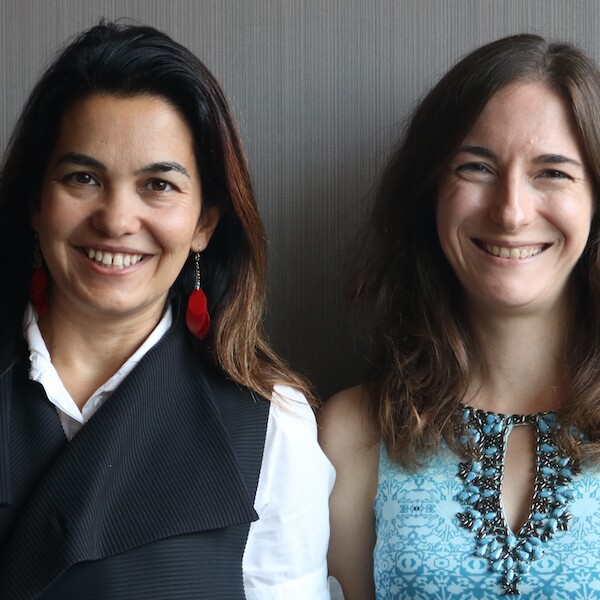
PHOTO/AVNI SHAH. BURCIN BECERIK-GERBER AND GALE LUCAS, CO-FOUNDERS OF CENTIENTS.
During the 11-week, free program, students gain exposure to myriad topics, ranging from the estimation of risk and protein engineering by directed evolution to the contributions made by computer science and electrical engineering faculty in automating human safety technologies, detecting misinformation and digital contact tracing. The one- to two-hour sessions take place on Thursdays at 6 p.m.
On Nov. 19, Burcin Becerik-Gerber, Dean’s Professor of Civil and Environmental Engineering, and Gale Lucas, Research Assistant Professor at the USC Institute for Creative Technologies, presented their lecture ”The Role of the Built Environment on Worker Productivity and Health during Work from Home.”
Becerik-Gerber and Lucas, also co-founders of the Center for Intelligent Environments (CENTIENTS) discussed results from their work from home survey, issued over the spring, and implications of how different home office setups and factors are positively or negatively influencing worker’s productivity and mental and physical well-being.
The following is a Q&A about the lecture.
For those who missed it, can you briefly summarize your lecture for a general audience?
Center for Intelligent Environments (CENTIENTS), which we co-founded last year, conducted a survey study to assess health and productivity impacts of working from home (WFH) during the COVID-19 pandemic. The survey specifically focuses on office workers and the final sample consisted of 988 respondents. Overall, the averge level of physical and mental well-being decreased compared to prior to WFH. Related lifestyle changes included reduced physical activity and exercise and increased food intake.
The results suggest that the overall productivity level of office workers did not change relative to that before the pandemic. However, responders indicated an increase in the number of working hours spent at a workstation by about 1.5 hours during a typical WFH day. At the same time, only one-third of respondents had a workspace with no other family members at home, less than one-third indicated having a good workstation set-up, and only 11% knew if and how their workstation was affecting their health, well-being, or productivity.
Of those respondents who said they knew how to adjust their workstations, only one-third reported that they had a good workstation set-up. Respondents who had a dedicated room for their workstation and knew how to adjust it had better mental and physical health and reported better productivity. Relatedly, productivity was positively influenced by better mental and physical health statuses, higher satisfaction with the thermal environment and more communication with coworkers.
Why is this research important? How will it help in the fight against COVID?
The COVID-19 pandemic has altered every aspect of our work and life, including that companies, organizations and institutions encouraged their employees to work remotely at home to stay safe. While many researchers have focused on the implications of the disease itself on health and well-being, we consider the consequences (bad and good) of this huge shift in the number of workers doing their jobs from home. While the work presented in this lecture does not directly address COVID-19, it touches on important effects of COVID-19, specifically productivity and health. It provides recommendations for a productive and healthy life during the pandemic as well as while working from home after the pandemic.
How would you compare your research to similar research or ideas, either in academia or industry?
Work from home (WFH) emerged in the early 2000s, when telecommuting technologies started to develop and workers could WFH to avoid commuting, but only certain kinds of workers used telecommuting. It often was not used exclusively, and everyone in the household (including children) were not all staying at home during the day. Because of these extensive changes to WFH and the ubiquity across sectors of the workforce (including healthcare), we need to understand the ramifications of WFH during the pandemic to shed light on how this experience has altered our bodies, minds and states of wellness. While there is research that investigated remote work’s impact on productivity or health, these prior works mostly focused on one company’s employees or similar types of work (U.S. Patent Office employees or Chinese travel agency’s employees). Our work includes responses from different groups of employees, locations, etc. Importantly, our work investigates the impact of workspace (e.g., workstation) and built environment’s (e.g., indoor environment quality) effect on worker health and productivity.
What are the next steps and/or milestones in terms of your work?
We are currently finalizing additional qualitative analyses. Specifically, through qualitative content analysis of responses to open text questions, we are also exploring people’s lived experience of work from home during the COVID-19 pandemic. While working from home increased flexibility and control over the temporal and spatial contexts of work, it also created challenges of setting and maintaining boundaries between work and home. In addition, we have been working on an intelligent workstation that optimizes thermal, visual and postural conditions for office workers. Please check:
https://www.medicaldesignandoutsourcing.com/smart-desk-knows-what-you-need-for-healthier-habits/
https://venturebeat.com/2018/09/03/how-researchers-are-designing-smart-desks-of-the-future/
We plan to integrate our results into our intelligent workstation, taking into consideration pandemic and post-pandemic circumstances, to improve worker productivity and health.
Tell us about your collaborators. What unique skills does each person bring? Are you partnering with any doctors, clinicians or other non-engineers in this work?
Dr. Becerik-Gerber works in intersection of machine intelligence and built environments and focuses on the acquisition, modeling, and analysis of the data needed for user-centered built environments, as well as the development of learning and control algorithms. Gale Lucas, her co-director for CENTIENTS, conducts social science research focused on understanding human-computer interactions, especially factors that increase acceptance and use of technology and the role of individual differences. They collaborated on this project with Shawn Roll who works in occupational science and occupational therapy. Dr. Roll’s expertise is the evaluation of complexities inherent in human occupational performance, particularly those factors related to interactions among individual human capacities, work tasks, and work environments (physical, social, political).
Can you share one story from your pandemic life? How has it impacted your work and family? What are you doing to stay sane?
It’s impacted our work by forcing us to adapt our human-subjects experiments to be mainly online (and we spend a lot of time in Zoom meetings). Dr. Becerik-Gerber has three school-aged children at home, who are attending school remotely, which has altered Dr. Becerik-Gerber’s life, bringing together parenting related responsibilities with work related ones. However, there is a silver lining in this: more time spent with her boys and husband as all of the family members are at home working/studying. Staying sane might be overrated but during the pandemic, Dr. Becerik-Gerber takes long hikes and also spends more time in her vegetable garden. Dr. Lucas’ family has experienced some positive impacts of WFH, as she gets to see her husband and her dog a lot more these days. Her dog, Ryder, is the happiest about WFH because the family is together all day. Coping for Dr. Lucas involves exercise with her pets, taking Ryder on long walks and spending time riding her horse, Skye.
From a research perspective, what do you consider the most surprising or counter intuitive aspect of the virus or the pandemic as a whole?
Teenagers are positive for productivity. Workers with at least one teenager living at home reported significantly higher productivity than those without one. A possible reason could be that teenagers are more independent and able to help with household tasks and even take care of younger siblings allowing workers to focus more on their jobs, reducing distractions.
What are some words of wisdom regarding the pandemic that have meant a lot to you?
Lucas: Look away from your computer screen for at least 30 seconds every 20 minutes.
Becerik-Gerber: Family comes first; this too shall pass. It is important to focus on health and well-being.
If you could only share one slide from your talk, what would it be and why?
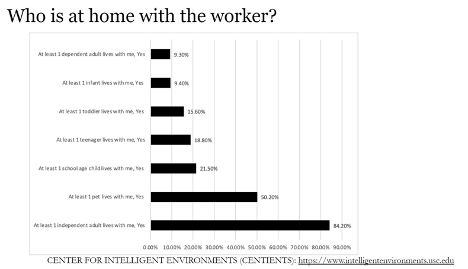
We would share the slide above, because it highlights what can make WFH during the pandemic so interesting, complicated and both a benefit and a stressor. WFH means we are trying to do work in the same place as children, parents, romantic partners, roommates, and also pets. These can be sources of distraction, but also means that balancing work and home life has become closer (in physical space) and harder to separate.
For more information on regulating the built environment to improve occupant comfort, productivity and well-being, see the recently published paper “Intelligent Agents to Improve Thermal Satisfaction by Controlling Personal Comfort Systems Under Different Levels of Automation.”
Published on November 24th, 2020
Last updated on February 11th, 2021




